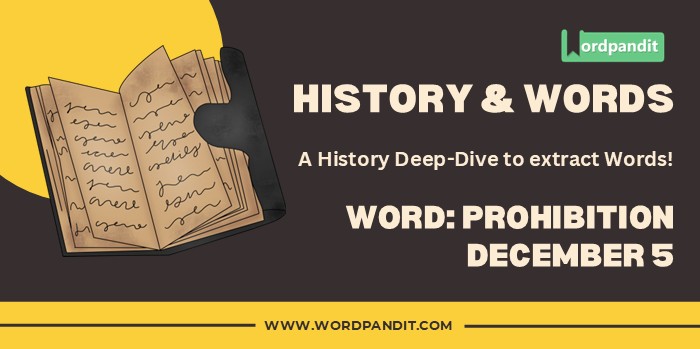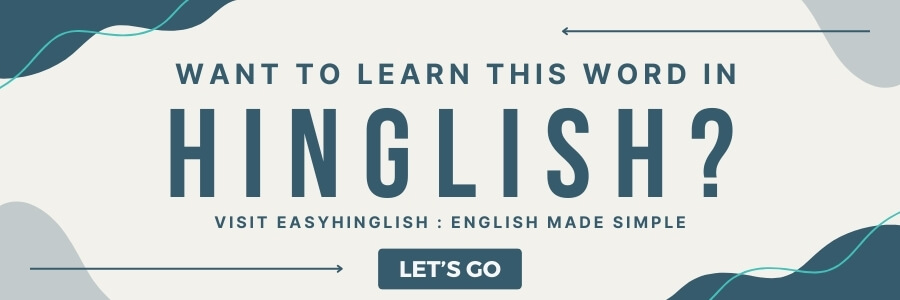History & Words: ‘Prohibition’ (December 5)
Welcome to ‘History & Words.’ 🌟 I’m Prashant, founder of Wordpandit and the Learning Inc. Network. This series combines my passion for language learning with historical context. Each entry explores a word’s significance on a specific date, enhancing vocabulary while deepening understanding of history. Join me in this journey of words through time.
📚 Table of Contents
🔍 Word of the Day: Prohibition
Pronunciation: /ˌprəʊɪˈbɪʃən/ (pro-ih-BISH-uhn)
🌍 Introduction
On December 5, 1933, the United States ratified the 21st Amendment to the Constitution, officially ending the nationwide ban on alcohol known as Prohibition. This historic moment marked the conclusion of a bold social experiment that had lasted nearly 14 years and dramatically shaped American society, politics, and culture.
The word “prohibition” came to define an era of American history characterized by speakeasies, bootleggers, and organized crime. While the term technically means any act of forbidding something by law, its association with the alcohol ban of the 1920s and early 1930s has become so strong that it’s often capitalized when referring to this period.
The repeal of Prohibition represents one of only two times in American history that a constitutional amendment has been repealed, highlighting the extraordinary nature of both the experiment and its end. The events surrounding Prohibition and its repeal continue to influence discussions about drug policy, regulation, and social reform.
🌱 Etymology
The word “prohibition” derives from the Latin “prohibitionem,” meaning “hindering, forbidding,” which comes from “prohibere” – “pro” (before) and “habere” (to hold). The term literally means “to hold back or prevent,” and has been used in English since the 15th century to describe the act of forbidding something by law or authority.
📖 Key Vocabulary
- 🔑 Speakeasy: An illicit establishment selling alcoholic beverages during Prohibition
- 🔑 Bootlegger: Someone who illegally makes or sells alcohol
- 🔑 Temperance: The movement promoting moderation or abstinence from alcohol
- 🔑 Volstead Act: The law that provided for the enforcement of Prohibition
- 🔑 Repeal: The revocation of a law or constitutional amendment
🏛️ Historical Context
The path to Prohibition began in the 19th century with the temperance movement, which viewed alcohol as a source of social problems including poverty, domestic violence, and workplace accidents. The movement gained momentum through organizations like the Women’s Christian Temperance Union and the Anti-Saloon League.
World War I provided additional momentum for Prohibition, as anti-German sentiment led to criticism of beer brewers, many of whom were of German descent. The war also established precedent for federal control over food and beverage production.
The 18th Amendment, ratified in 1919, prohibited the manufacture, sale, and transportation of intoxicating liquors. The Volstead Act, passed the same year, provided for enforcement and defined intoxicating liquors as anything with more than 0.5% alcohol.
⏳ Timeline
- 1830s: Beginning of organized temperance movement
- 1919: January 16 – 18th Amendment ratified
- 1919: October 28 – Volstead Act passed
- 1920: January 17 – Prohibition begins
- 1929: Stock market crash and Great Depression begin
- 1932: Franklin D. Roosevelt campaigns on Prohibition repeal
- 1933: December 5 – 21st Amendment ratified, ending Prohibition
🌟 The Day’s Significance
December 5, 1933, marked the end of a controversial chapter in American history. Utah became the 36th state to ratify the 21st Amendment, reaching the three-fourths majority needed for constitutional change. President Roosevelt signed a proclamation officially declaring the end of Prohibition.
The repeal reflected changing social attitudes and economic realities. The Great Depression had made the economic arguments for repeal more compelling, as legal alcohol sales could provide tax revenue and jobs. The failure of enforcement and rise of organized crime had also undermined support for Prohibition.
The end of Prohibition led to new systems of alcohol regulation, with states gaining authority to set their own alcohol policies. Some states maintained prohibition at the state level, while others quickly established licensing systems and alcohol control boards.
💬 Quote
“What America needs now is a drink.” – Franklin D. Roosevelt, upon signing the legislation that would lead to Prohibition’s repeal
🔮 Modern Usage and Reflection
Today, “prohibition” is often invoked in debates about drug policy and regulation. The lessons of Prohibition inform discussions about marijuana legalization, drug enforcement, and the broader relationship between law and social behavior.
The term serves as a cautionary tale about the challenges of legislating morality and the unintended consequences of blanket bans on popular substances.
🏛️ Legacy
Prohibition’s legacy extends beyond alcohol policy. It influenced the structure of organized crime in America, the expansion of federal law enforcement, and approaches to regulation of controversial substances.
The period also left lasting marks on American culture, from speakeasy-themed bars to cocktail culture, which flourished as bootleggers mixed drinks to mask the taste of poor-quality alcohol.
🔍 Comparative Analysis
While the original Prohibition focused solely on alcohol, modern prohibitions target various substances and activities. Contemporary debates often reference the 1920s experience when discussing the effectiveness of banning widely-used substances versus regulation and harm reduction approaches.
💡 Did You Know?
🎓 Conclusion
The repeal of Prohibition on December 5, 1933, marked the end of a unique social experiment in American history. Its lessons about the challenges of enforcement, unintended consequences, and the relationship between law and social behavior continue to inform policy discussions today.
📚 Further Reading
- 📘 “Last Call: The Rise and Fall of Prohibition” by Daniel Okrent
- 📗 “Dry Manhattan: Prohibition in New York City” by Michael A. Lerner
- 📙 “The War on Alcohol: Prohibition and the Rise of the American State” by Lisa McGirr












